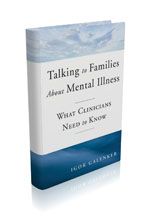Publication
Article
Psychiatric Times
Talking to Families About Mental Illness: What Clinicians Need to Know
Author(s):
Talking to Families About Mental Illness aims to help primary care providers who want to offer family psychoeducation. This book targets non-psychiatrists who diagnose and treat mental illnesses.
Our ability to provide family psychoeducation varies, and Talking to Families About Mental Illnessaims to help primary care providers who want to offer family psychoeducation. This book targets non-psychiatrists who diagnose and treat mental illnesses.
Dr Galynker’s writing style is one of knowledgeable advisor. He gives first-person advice supplemented with vignettes that paraphrase what he has said to patients and their families. He stresses the importance of finding and supporting existing family strengths and reminds the reader to blame the illness, not the family.
He offers useful pearls of wisdom that can be applied in daily practice. For example, telling the patient’s family that “severe depression feels as bad as having a 104-degree fever” (page 75), he helps them recognize that depression is an illness, not a character flaw. While the pearls are useful, there are times when Dr Galynker appears to be talking down to his audience. He declares that psychotropic medications should only be prescribed by psychiatrists and that “a little knowledge is a dangerous thing, and non-psychiatrists simply do not have the training necessary to know when psychotropic medications will do more harm than good” (page 89).
The author seems to rely heavily on his own clinical experience and not enough on the evidence. Given that primary care providers lack the depth of information on mental illnesses that psychiatrists have, it is arguably more important for him to provide the data to support his contentions. In a section of the book where he offers information on how to work with families that prefer therapy over medications or vice versa, he writes that “pharmacotherapy alone is indicated for schizophrenia” (page 95). The reader may be unfamiliar with the evidence on psychosocial treatments of schizophrenia, and it would have been helpful if this information had been presented in the book.
The sound information in this book can be easily used by those who are already familiar with the literature on psychoeducation. Informed providers will know how to glean the pearls and discard the material that is either incomplete or inaccurate, but the uninformed will not. Therefore, it’s hard to recommend this book to primary care providers and others who aren’t familiar with the biopsychosocial treatments of mental health disorders who want to offer family psychoeducation.






